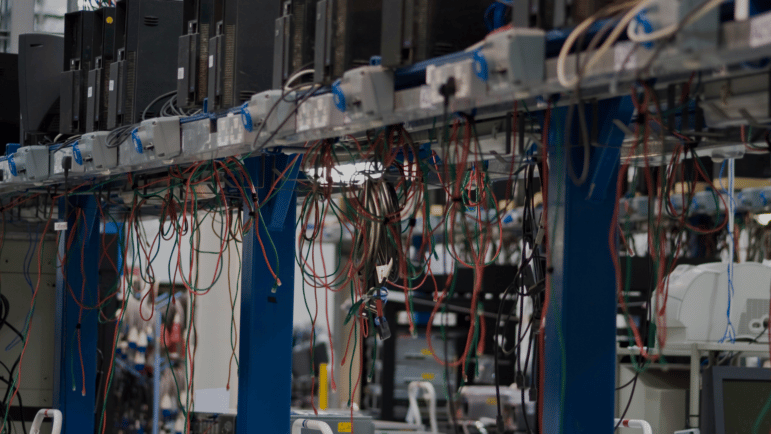Overall Equipment Effectiveness (OEE) is one of the most vital metrics you can track as an electronics manufacturer; it’s considered to be the “gold standard” for measuring your effectiveness.
OEE is like a stool with three legs. One of those legs is Equipment Availability (the other two legs are Equipment Performance and Product Quality). Here’s what you need to know about this important OEE metric:
- Equipment Availability measures how often your machines are running when they are supposed to be running
- Equipment Availability indicates the ratio of scheduled time that your operation is available to operate
- Equipment Availability is expressed as a percentage
- Your goal with Equipment Availability is to achieve 100%, which means your process is always running during planned production time.
You calculate your Equipment Availability by dividing your actual production time (in minutes) by your potential production time (in minutes). You then multiply your result by 100 to achieve a percentage. For example:
Potential Production Time: 12 hours = 720 minutes
Actual Production Time: 11.5 hours = 690 minutes
Time Loss: 1/2 hour = 30 minutes
690 / 720 = 0.958
0.958 X 100 = 95.8%
Equipment Availability Score: 95.8%
Common Causes of Machine Unavailability
Don’t be surprised to discover that your Equipment Availability is rarely (if ever) a perfect score of 100%. There are many explanations for electronics manufacturers not achieving 100% Equipment Availability. Here are the top ones.
- Setup and adjustment: Each one of your shifts begins with time spent getting the equipment prepared and calibrated for production.
- Machine breakdowns: Equipment breaks down unexpectedly.
- Material shortages: Each machine requires materials or parts to be productive. When these materials and parts are missing or slow in finding their way to your equipment, the machine sits idle.
- Changeover time: Your equipment sits idle as a line or machine is converted from running one electronic device or component to running another.
- Blocks: Sometimes a sensor gets blocked, a piece of material misfeeds, or the machine simply jams.
- Idle time: Tea breaks, meal breaks, and other interruptions leave equipment off and idle.
- Start up: Getting equipment calibrated and running again after a repair, or after a holiday break, reduces Equipment Availability.
How to Improve Equipment Availability at Your Electronics Manufacturing Plant
Your Equipment Availability score is something that you can improve in several ways. For one thing, you can conduct preventative and predictive maintenance. This helps you avoid equipment failures and unscheduled downtime.
You can also take steps that are focused on gathering and addressing machine data.
Monitor every piece of equipment that counts: Equip each machine used in production with a condition-based IIoT monitoring device, ideally one that measures in real time. You may find that your newer machines are already running with these IIoT devices installed. If not, find a third-party solution. What you should do is install one device on every machine in your process that matters.
Monitor all machines from one place: The key to optimizing your Equipment Availability to consolidate all machine data in one application. This way, using a variety of dashboards, you see at a glance how well your plant is performing.
Consider a tool like OEE CONNECT from MCA Connect, for example. This OEE platform monitors and analyzes your Equipment Performance in real time. It helps you predict facility production more accurately so that you optimize Equipment Availability.
 Image 1. Consolidate your IIoT device data into OEE dashboards that help you see exactly where you stand in real time with your Equipment Availability.
Image 1. Consolidate your IIoT device data into OEE dashboards that help you see exactly where you stand in real time with your Equipment Availability.
Analyze root causes of problems: Look for—and solve—the root causes of your poor Equipment Availability. Avoid applying quick fixes and spot solutions. They are only temporary, and don’t address the root cause of your Equipment Availability issues. What you must do instead is conduct root cause analysis of your machine breakdowns, blockages, idle time, and other issues, and then take the steps needed to get rid of these root causes.
Ask your operators: Everyone likes to be asked for their expert opinion—including your equipment operators. So, ask them for their opinions about the causes of your Equipment Availability issues. They likely know.
After all, no one else in your plant is as familiar with your equipment as your operators are. They already know which machines break down (and why), they already know how, where, and why jams occur, and they are more than ready to tell you why your setup and adjustment times are as long as they are.
The way you gather these answers should be formal, systematic, and ongoing. Using an OEE performance monitoring platform like OEE CONNECT, for example, you connect your shop floor data and operator feedback with your back-end Microsoft Dynamics 365 ERP. When your operators receive alerts sent to the Operator App, the platform prompts operators to confirm and troubleshoot the issues. This helps you visually (and quickly) understand critical manufacturing KPIs.
 Image 2. A tool like OEE CONNECT displays input from your shop floor operators and integrates that data with data found in your Machine Historian. This helps you discover where you must look to improve your Equipment Availability score.
Image 2. A tool like OEE CONNECT displays input from your shop floor operators and integrates that data with data found in your Machine Historian. This helps you discover where you must look to improve your Equipment Availability score.
Conduct predictive maintenance: One way to reduce unscheduled equipment downtime caused by equipment breakdowns is to conduct scheduled maintenance. But a better solution in many instances is to conduct predictive maintenance. Predictive maintenance monitors the performance and condition of your equipment during normal operation to predict the likelihood of equipment failure—so that you avoid it. It replaces calendars with calculations.
Prioritize your assets: You can’t fix every machine at once, so prioritize your efforts based upon dependency. Invest your energy, time, and budget on the machines that have the greatest impact on your process. Start by mapping your production process, showing visually how each machine affects the other equipment downstream.
Then look to see how improving the availability of one piece of equipment will immediately improve the availability of many others in your process.
Conclusion
If you are an electronics manufacturer and you need to boost your OEE by improving your Equipment Availability, consider combining your machine data with insights from your machine operators. By consolidating your IIoT data into one application, and by having regular, frank conversations with the folks who operate your machines, you ensure that you understand the root causes of your Equipment Availability issues and know what you must do to resolve them.
If you need help improving your OEE, check out OEE CONNECT. This exclusive offering from MCA Connect accelerates your journey to Manufacturing 2.0 by capturing manufacturing data and operator insights at scale.
Author: Doug Bulla, Senior Vice President, Solution Development


